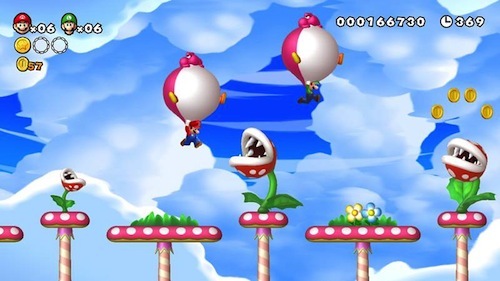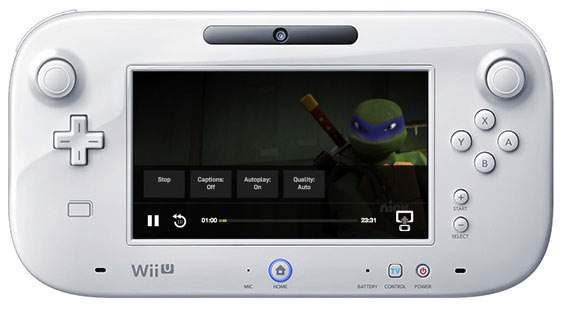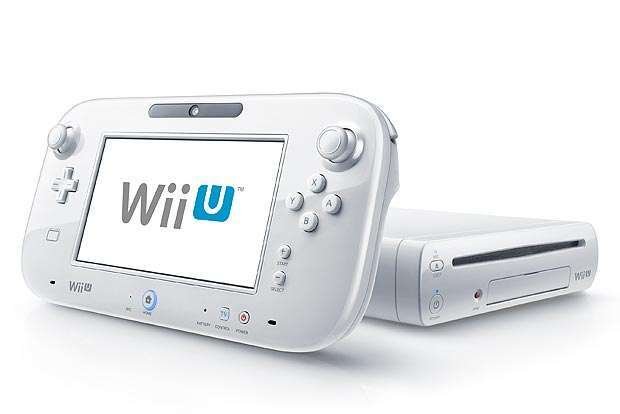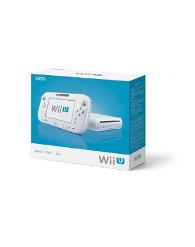Wii U 8 GB
Overview -
Nintendo's fortunes have been wildly up and down this gaming generation. Microsoft and Sony were putting all their chips on glossy, expensive, high definition consoles with integrated marketplaces and social networking options. Additions like achievements, streaming video services, DVD and/or Blu-ray playback and download-only arcade titles turned these consoles into home theater hubs instead of simply video game systems. Nintendo went the other way, introducing the Wii, a low price console with a unique controller that relied on motion control. At first, the Wii was a hit, with everyone and their mother (and their mother's mother) wanting one. Stores couldn't keep the system in stock long after the concurrently-released PS3 stopped being scarce.
But the runaway success was not to last. In order to deliver the console at such a low cost, Nintendo had to cut back on several areas that made the Wii severely deficient when compared to the 360 and PS3. No HD, poor online services, and lack of strong third party support meant that Wii sales stalled out just when the other two consoles were showing profits for their parent companies. Nintendo realized that they could not continue to compete with only the Wii, and needed a shot in the arm. Enter the Wii's successor, the Wii U.
The Wii U is designed to be everything the original Wii should have been. Sporting technical specs that are comparable or better than the existing rival consoles, the Wii U offers HD gaming, an integrated online service, and streaming services. Not only that, but it comes packaged with an intriguing new controller, dubbed the GamePad. Is the Wii U going to be the hail Mary pass that revives Nintendo's flagging fortunes, or will it be the last gasp of a struggling video game titan?
Video Review
 |
Other than the GamePad, the biggest selling point of the Wii U is that it's the first Nintendo system to offer full HD graphics. In that department, they don't disappoint. Games on the Wii U look gorgeous. There's nothing like popping in 'New Super Mario Bros U' and seeing Mario, Luigi, Bowser, and Princess Peach beautifully rendered in high definition. Multi-console ports no longer have to be stunted. 'Assassin's Creed III' on the Wii U looks gorgeous, and offers streaming to the GamePad to top it off. At least one developer has already vocally complained about the Wii U being underpowered, but it seems all the developers releasing launch titles had no problems.
With a HDMI 1.4 connection, the Wii U supports 3D. However, as it doesn't do Blu-ray playback, it limits the amount of 3D content available. 'Assassin's Creed III' does offer several 3D options, and while the merits of 3D gaming is certainly debatable, there's no doubt that if you have a 3D-capable television and compatible glasses, the Wii U will give you the experience you crave. And if the streaming video services should ever upgrade to offer 3D, in theory the Wii should be able to handle that as well. YouTube does offer some 3D streams currently, but as the YouTube app has not yet premiered on the Wii U, we cannot say whether you can access YouTube's 3D videos on the system.
Using streaming apps for HD results in a pleasing, sharp HD image. Netflix was prone to lowering the quality of the video on the fly should the Wi-Fi connection slow down. Hulu Plus allows the user to control the video quality, giving you greater flexibility based on your particular connection.
Unfortunately, the GamePad is saddled with a decidedly low res 854x480 display. As far as things go the display doesn't look bad, but in a world where people can watch movies in HD on their phones, standard def doesn't cut it for a device that's meant to be the new lynchpin of your home theater. Streaming movies on your TV looks great. Bumping it down to the GamePad makes you wonder if there's a better way to get the same feed. If you have an iPad with Retina Display, there is no reason to use any of the streaming services on the GamePad, because the iPad looks light years better than the GamePad ever could, and unlike the GamePad you can take the iPad anywhere within range of your Wi-Fi network. Of course, not everyone has a portable tablet, which is why it's all the more frustrating that Nintendo skimped out on the resolution for the GamePad. Given that the mobile sector is generating real competition for traditional video game vendors, you'd think that Nintendo would want to do everything it could to prevent people from desiring a standalone tablet in addition to, or even worse instead of the Wii U. Perhaps an HD display was cost prohibitive. Perhaps streaming a seamless HD signal to the GamePad was too taxing on the Wii U's resources. The reasoning behind it won't matter to the consumer making a decision on which gadget to buy for the holidays.
 |
Given that we don't have the specifics of the Wii U's CPU, it's hard to say how the system will hold up over time as graphical demands increase. What we can see is that at launch the graphical output of the system isn't significantly better than the PS3 or the 360. Of course, that's to be expected, as no system puts its best foot forward on day one. In fact, by coming out in the middle of the generation cycle, the Wii U benefits from ports that look like mature titles on the other consoles. But make no mistake, for a system that could be considered next generation, the graphics look decidedly this gen. You're not going to plug in the Wii U and be blown away in the same way you were when you switched from an Xbox to the 360. Part of it is that the 360 and PS3 took gaming from standard definition to high definition, which gave off a big wow factor. The Wii U came too late to catch the benefit of that initial HD rush. The question is, how will the Wii U fare when the inevitable next-gen Microsoft and Sony consoles make their debuts?
Audio Review
According to the released specifications, the Wii U offers support for six-channel linear PCM. As the system doesn't play DVD or Blu-ray, there's no need for it to support other lossless codecs, although many games are coded using Dolby Digital. Whether or not it could support other codecs in the future is unknown at this time. Not that there's anything wrong with PCM, which is lossless, uncompressed sound. 'Assassin's Creed III' sounds just like you'd expect on the other consoles, with plenty of sonic details and panning surround action. Streaming services also sounded just as good as they did on the other consoles.
The GamePad also has a pair of speakers, which offer loud, clear sound. In fact, it’s so loud and clear that you will want to turn the sound off most of the time, because more often than not the GamePad is going to output the same sound you're getting from your TV. Asynchronous gaming may or may not require using the speakers, depending on the game in question. Turning off the sound is also a good way to preserve precious battery life on the GamePad. When watching video or playing games directly through the GamePad, you can either use the built-in speakers or plug in headphones if you don't want to disturb everyone else in the house.
 |
The Wii U is a bit of an enigma. Clearly Nintendo has a bold vision of where they want to take gaming. The GamePad is full of powerful tech and can be implemented in dozens of creative ways. If used right the GamePad could become a powerhouse, turning gaming on its head. Ideas like allowing external storage up to 2 TB feels incredibly forward-thinking. Unfortunately, for all the potential inherent in the system, it's currently besieged by poor design decisions that prevent it from being a total success. The UI is a holdover from the Wii, and the OS is plagued by inexplicably long load times. Nintendo finally offers an integrated social service, but the functionality is shallow and implementation isn't system-wide. The whole experience of using the Wii U feels disjointed.
Then there's the question of whether the Wii U can stand up to the next gen consoles that Microsoft and Sony haven't even unveiled yet. Right now the Wii U feels like Nintendo playing catch up to consoles that are over half a decade old. In time, the Wii U could become a genuinely great system, provided that Nintendo overhauls the OS, games and apps make smart use of the GamePad, and third party support remains strong. But people don't buy products for what they could be; they buy them for what they are. Right now, whether the Wii U is worth $300 or more will depend greatly on how much you like Nintendo, and how much you believe in the GamePad concept.












